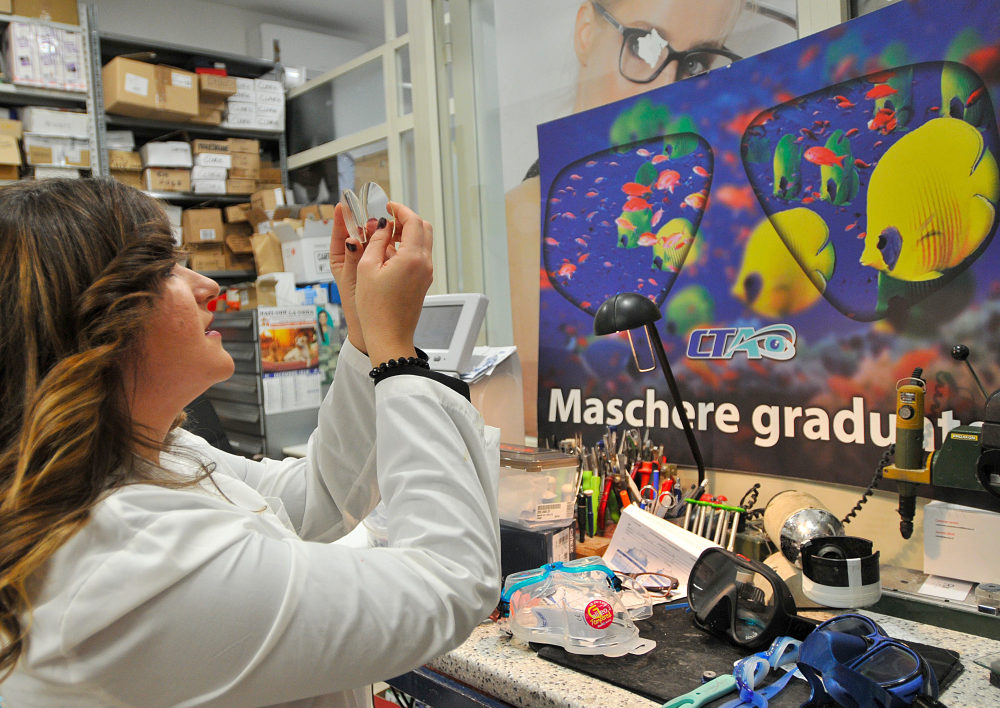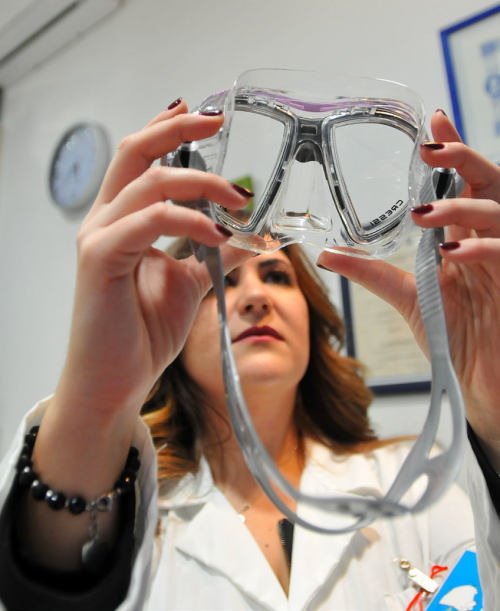
I want to see it clearly …
What I am about to describe may look like a trivial topic, one of those things that seem “obvious”, but given my personal experience and after having talked about it with many of my clients (I own a diving center in Sharm el Sheikh specialized in underwater photography, the Bubbles Dive Club, where I often hear about various sight problems), I noticed that the issue has a certain relevance.
It is undeniable that the average age of divers is rising and, after forty years of age, vision problems arrive.
The manufacturers of underwater housings have helped us with the various magnifiers that allow a better view in the viewfinder, but for that growing number of compact cameras users, without a viewfinder, and for those who want to be sure that their last shot is in focus, there is little to do except using a graduated diving mask.
Someone offers contact lenses also for presbyopia, but the performance is really unsatisfactory. Which brings us to why I thought of writing this article: I am at my third graduated mask and finally “I saw the light”.
In most cases, they ask you what grade you need and glue lenses to the mask …
Personal result: the first one made me turn my head if I looked from both eyes, the second had the additional lenses mounted too high and, when I didn’t want to use them, I had to look with my eyes upwards, in an unnatural position that brought me considerable discomfort.

By chance, I came across a girl, Claudia Becherucci, who turns out to be the owner of an optician shop with a well-equipped lens processing laboratory.
Well, maybe because she is a scuba diver too, maybe because she too has vision problems, but she does this job with an incredible passion.
I’ll tell you how she behaves so that you can understand what to ask your trusted optician, unless you do not want to contact her directly given that she delivers all over the world.
Just be prepared to give her the set of parameters you’ll be required.
To better understand, I made her a small series of questions that I report.
Me:
Hello Claudia. I decided to ask you a few things after becoming one of your happy customers. You have now become one of the reference points in Italy for those who “want to see clearly under water”, and I know that your masks are also being requested from abroad. Personally, after having already had two, I found your work absolutely different and I would like to understand why. What do you ask to those who order you a graduated mask?
Claudia:
In addition to the classic parameters that are requested, but not always taken into account, the fundamental thing for a photographer remains the height of the segment and, for higher corrections by presbyopia (greater
than 3 diopters) I usually avoid giving the full correction, but under-correct by 0.50 / 0.75 so as not to have a lens that is too thick at the edge when passing from near to far and, more importantly, allowing a more flexible focus point from near (i.e. not too close).
Among other things, as per the segment height, I ask whoever orders the mask from outside either to mark the pupillary point on the mask or, in case they have to order it from me, I adjust based on the mask model.
Yours for example, which has inclined glass and therefore widens your field of vision, MUST be centered a little lower precisely because the inclination already brings the lens closer to your eye.

Me:
When I ordered the mask, you took my inter-pupil distance. If I had to order the mask online from you, who would provide me this data?
Claudia:
Definitely your ophthalmologist, from whom we should remember well how important it is to be examined every now and then.
Me:
Are all masks eligible for becoming optical masks?
Claudia:
The choice of the suitable mask for underwater photography and video shooting is essential to obtain a satisfactory result. Not all of the models of masks on the market are in fact suitable for the mounting of presbyopia
corrective segments or for a bifocal correction, and thanks to our decades of experience we are able to supply the best advice based on the optical correction to be made and the personal needs of the photographer.
Me:
Explain yourself better: on what basis should I choose one mask instead of another?
Claudia:
Some masks models have features allowing them to better adapt to your face morphology and the optical correction to be applied.
The parameters to consider and recommend are definitely a particular “drop” shape, deeper in the lower part, as well as an inclination of the front towards the face that allows to bringing the lenses closer to the eyes and
consequently significantly increase the visual field, both peripheral than in proximal distance vision.
Moreover, the masks with removable frames allow an easy “transfer” or replacement of the optical lens in the case of losses and / or silicone ruptures, but also the replacement in case the optical correction is to be increased or modified.
Me:
Once you choose the right one, what will happen to our mask?
Claudia:
Regarding the processing phases of the graduated mask, particular attention must be paid to the pre-gluing cleaning phases of the lenses with specific products.
This allows us having an excellent performance over time by avoiding the infiltration of water between the two lenses, afterwards highlighted by dirt, as well as eliminating as much as possible the annoying fogging that frequently creates problems during diving.
In addition, the use of top quality adhesives that have the same refractive index as the glass avoids any type of distortion, ensuring excellent optical quality.

Thanks Claudia, keep it up. I’m looking forward to unveiling the project you told me about, which will be an incredible innovation for us who need optical masks.
WORDS and PICTURES by Pierpaolo Peluso

















